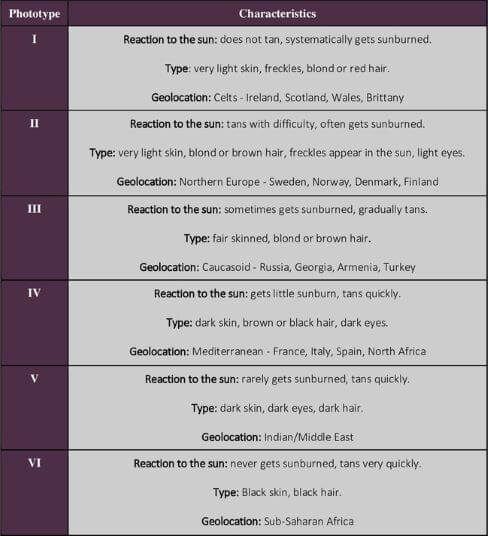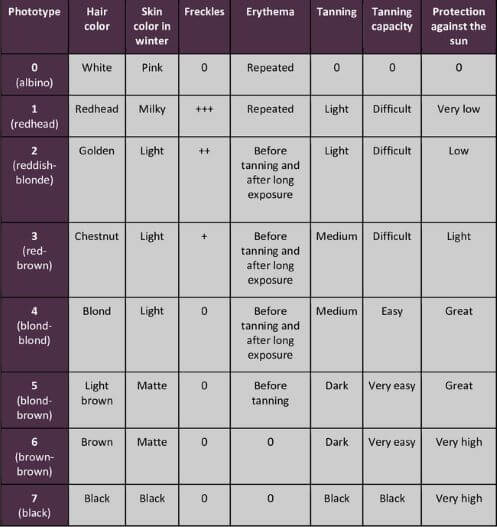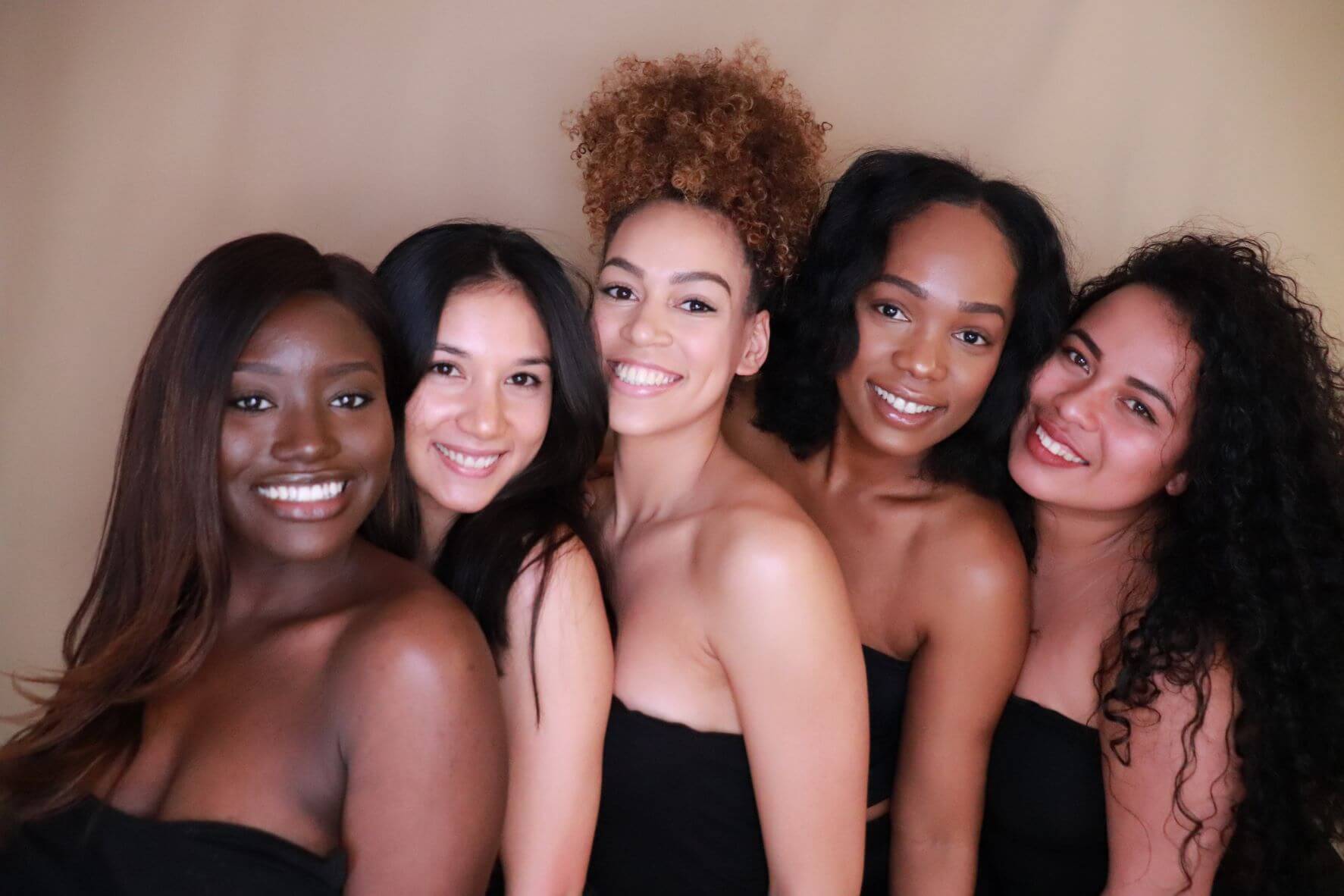Everyone has always known that not all skin is equal when it comes to the sun. Indeed, our skins react and tan differently when exposed to the sun.
Based on this observation, several researchers have succeeded in developing classifications. Their objective is to group the different types of skin into "phototypes". To do this, they take into account the color of hair, eyes and skin (skin tone). Each phototype is also determined by the skin's sensitivity to the sun's ultraviolet rays.
It is therefore important to know your phototype in order to choose a specific skin care routine. Indeed, it will be adapted to the pigmentation of your skin and to all its complementary needs.
The importance of knowing your skin phototype
Skin phototype is considered to be mainly related to the pigmentation of the skin and the ratio of eumelanin (brown pigments) to pheomelanin (yellow, red pigments) that it contains. Each individual has both pigments but in different proportions and it is the variability of these pigments that determines our skin color.
Caucasian skins express pheomelanin to a greater extent while black, dark and mixed race skins express eumelanin to a greater extent.
It is now known that these brown pigments have the ability to absorb the sun's UV rays, which partially protects darker skins from its harmful effects. Their photoprotective character leads to the following conclusion: the more eumelanin the skin contains, the darker it will be and the more naturally it will be protected from the sun.
However, it is important to remember that whatever the skin tone, this so-called natural protection is insufficient. The skin phototype therefore helps to predict possible sun damage to the skin. The most benign are dehydration or tightness and the most dangerous may be the appearance of skin cancer.
Understanding the Fitzpatrick Classification
Fitzpatrick's classification is not the first to have been created, but it is the best known today. In 1975, Dr. Thomas B. FITZPATRICK, a dermatologist at Harvard University, had the idea of distinguishing, with the help of a questionnaire, the different types of skin according to several criteria: their sensitivity to ultraviolet radiation and their ability to tan and/or to sunburn.
This classification into six phototypes makes it possible to evaluate, for each type of skin, the risk linked to sun exposure and the importance of the required protection.
The objective of this classification was initially to be able to distinguish, according to the phototype of a patient, the aesthetic treatment (lasers) to be used accordingly.
How the Fitzpatrick questionnaire works
Although subjective, the use of Fitzpatrick's classification for diagnostic purposes or therapeutic treatment has been proven.
This classification is presented in the form of a questionnaire of 10 questions, each answer of which is worth between 0 and 4 points. These are simple questions about hair color, eye color, skin color and its tendency to sunburn or tan. At the end of this questionnaire, the points are added up to obtain a final score that allows us to determine the skin phototype.
Questionnaire determining skin phototype according to Fitzpatrick's classification

Total points
Between 00 and 07 points → phototype I
Between 08 and 16 points → phototype II
Between 17 and 25 points → phototype III
Between 25 and 30 points → phototype IV
Between 30 and 35 points → phototype V
Between 35 and 40 points → phototype VI
Based on the same principle of questioning, our solar skin diagnosis also allows you to obtain in a few clicks your phototype and all our personalized advice according to it.
Determine and understand the skin phototype
Skins are classified into six different phototypes:

Presentation of the Fitzpatrick classification according to six phototypes and their characteristics
- Phototypes 1-2-3 are represented by so-called "Caucasian" skins. They are characterized by fair skin, red, blond or dark brown hair and blue-green or light brown eyes. They do not tan or tan slightly and sunburn easily.
- Phototypes 4-5-6 correspond to black, dark and mixed skin. They are characterized by dark skin, hair and eyes. They tan easily without developing sunburns.
Although practical, Fitzpatrick's classification remains rather general. Indeed, it is increasingly difficult to successfully classify the different skin types according to the diversity of mixtures existing in the world today. Moreover, since its publication, it has been demonstrated that darker skin types are also sensitive to sunburn. Each skin tone is unique and therefore the statement that black skin never gets sunburned is not always true.
What if Fitzpatrick's classification is not the most accurate way to identify your phototype?
According to some researchers, Fitzpatrick's classification is not perfect because it excludes certain characteristics of the skin. For example, the phenotypic character (melanotype) is not taken into account.
The phenotype describes all the observable characteristics of an individual (eye color, human height, ...). It depends on the expression of the genotype (set of genes transmitted by our parents) and its environment.
The melanotype, a skin classification too often forgotten
In 1981, a new classification based on the melanotype was created by a team from INSERM (Institut National de la Santé et de la Recherche Médicale).
The melanotype determines the quality of the melanins produced. Subjects who produce mainly pheomelanins (light pigments / procancerigenic) are unable to have a protective tan during sun exposure. They are called melanocompromised. On the other hand, people who tan easily produce mainly eumelanins (brown pigments/ photoprotective). They are said to be melanocompetent.
Contrary to Fitzpatrick's classification, the one issued by the INSERM teams determines 8 phototypes. They are defined according to hair and skin color in winter, the presence or absence of freckles and erythema, tanning and finally the protection of the skin against the sun.
Presentation of the melanotype according to eight phototypes and their characteristics

This classification is less restrictive and more current. Indeed, it has been shown that black, dark and mixed skins, of phototype 5-6-7, have a very high level of protection against the sun. However, unlike Fitzpatrick's classification, it does not exclude the fact that pigmented skin also needs a sunscreen to protect it.
Preventing the dangers of the sun
The sensitivity of the skin to solar radiation is demonstrated through each of these classifications. It is therefore important to select a sun protection product in accordance with your phototype.
Black, dark and mixed-race skins need, as for Caucasian skins, a sun protection of index 50 against UVA/UVB rays. This will protect the skin from the risks of dehydration or accelerated skin aging. It will limit the appearance of redness and/or hyperpigmentation spots.
Moreover, so that this one is 100% specific with the pigmented skins, the addition of the vitamin D Like in its formulation brings a true added value to this protection. Indeed, pigmented skin suffers mostly from vitamin D deficiency due to the photoprotective nature of its eumelanins.

To prevent the skin from the dangers of the sun, it is also important to :
READ THE WHOLE ARTICLE
Add to favourites






